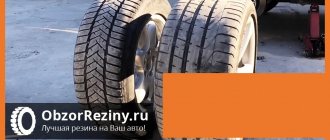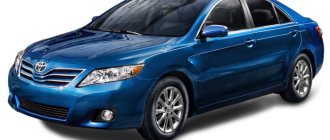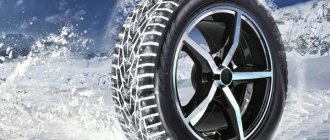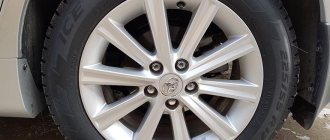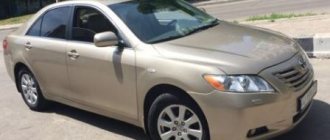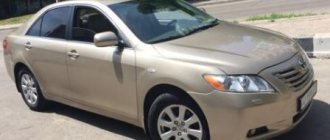A car wheel always consists of two parts: a tire and a rim.
There are several types of rims currently in use:
- Cast;
- Stamped;
- Forged.
Below in the article we will discuss the features of selecting wheel rims for a specific car, or more precisely for the Toyota Camry XV 40. The best choice for the owner of this car model will be original, non-used 16-inch alloy wheels.
Specification of alloy wheels
The Toyota Camry XV 40 sedan was produced in the period 2006-2011. There are several specifications that differ depending on the country of release. Let's look at rims and the difference between them. The model after 2009 has undergone minor changes, the changes affected mainly the body, but this does not apply to the wheels, so there is no need to worry about finding castings specifically for this version.
The importance of casting selection is also reflected in what kind of tires will need to be supplied. The most common type of disc is R16.
It was the one that was most widespread throughout the world. More expensive trim levels include R17. Their task is to highlight the appearance of the car. But if you are not looking for improved appearance, then the previous version will be quite enough. There is also an R18 package, but it is not available in our country. It exists exclusively for American Camrys.
For a clearer understanding, the table is presented below
As you can see from the table, there are no original R19s, this is worth mentioning right away so that you do not fall for the deception of dishonest entrepreneurs.
The best manufacturers
Some of the best summer tire brands suitable for the Camry V40 include:
- Yokohama Bluearth ES32 215/60 R16 99V, designed for driving on paved roads. Designed for a load of up to 775 kg, which allows you to operate the car with a trailer. The permissible speed is up to 240 km/h (above the dynamic capabilities of the machine). The rubber is stable on dry and wet surfaces, but at air temperatures above +30°C, road grip deteriorates.
- Pirelli Cinturato P7 215/60 R16 99H, designed for speeds up to 210 km/h. It is distinguished by its increased softness of the composition (does not harden at an air temperature of +3°C), does not make noise when driving and smoothes out unevenness of the road surface. The disadvantage is the weak side part; when hitting curb stones, the cord is destroyed.
- Continental Conti Premium Contact 5 215/60 R16 95V, characterized by a reduced load capacity of 690 kg. Provides good handling, but is damaged when the sidewall hits curbs or uneven road surfaces. Not suitable for driving on wet ground or grass: the shallow tread becomes clogged with dirt and prevents the car from moving.
- Bridgestone Ecopia EP200 215/60 R16 95H, designed for speeds up to 210 km/h. The load should not exceed 690 kg. The tire is insensitive to ruts and reduces fuel consumption. It is not designed for sharp maneuvers and turns. At speeds above 150 km/h, the car begins to sway and “float” along the road.
For winter operation of the Camry V40, non-studded or studded tires with dimensions 215/60 R16 are used.
Winter tires are made of a special material designed for reduced driving speeds. For example, the product Dunlop Winter Maxx WM01 215/60 R16 99T (without studs) can withstand speeds of up to 190 km/h. Its load capacity is 775 kg.
Dimensions of standard components
Casting parameters will depend on what wheel size you have chosen. The choice of standard wheels comes from 2 sizes: R16 and R17, due to the lack of R18 in our market. Drilling and overhang of standard discs are represented by the same values. The diameter of the center hole and the dimensions of the nuts are also the same. The only difference between the specifications is the width of the rims. Regardless of the modification (Toyota Camry 2.4 167 hp, Toyota Camry 3.5 V6 277 hp), the casting is suitable for everyone. Bolt pattern, drilling, offset and other parameters of the disk.
The best winter non-studded tires for Toyota Camry
Friction tires are the best choice for a big city, where the asphalt is clean even in winter. In addition, such tires are more comfortable to drive and quieter.
The rating includes 3 optimal tire models for Toyota Camry.
Bridgestone Blizzak LM005
Description of the tire. Friction tires with a directional symmetrical gull-shaped tread pattern. The model is new, appeared on the market in the winter of 2019/2020.
The compound contains a significant addition of silica to improve grip on wet and snow-covered roads.
The additive maintains the elasticity and softness of rubber even in extreme cold. The characteristics of the mixture are stable over a wide temperature range.
The side grooves are widened and deepened. This improved the efficiency of draining water, slush, and self-cleaning from snow. The pattern also led to better grip and maneuverability on snow.
The cutting of the lamellas is optimized for grip on ice. The sides are elastic, but thin.
Pros of Bridgestone Blizzak LM005
- Not noisy.
- Stable in a straight line.
- Does not float at temperatures up to +15°C.
- The seat is deep, which protects the disc.
- Good grip on asphalt.
- Doesn't slip on water.
- Good cross-country ability in snow and porridge.
Cons of Bridgestone Blizzak LM005
- Thin sides.
GOODYEAR Ultra Grip Ice 2
Description of the tire. The tire pattern is directional, in the form of gull wings, symmetrical.
The compound used received the loud name “cryoadaptive”. In practice, this means maintaining elasticity in cold temperatures below - 25⁰C.
The tread pattern is made up of arrow-shaped blocks. They are cut with thin slits and lamellas. The edges of the clutch are long, they are located at a considerable inclination to the direction of movement.
The pattern promotes high traction and grip qualities, high stability, and noise reduction. The shoulder blocks are massive and large. They improve handling and cross-country ability in snow.
The channels of the drainage system are large, this improves the removal of water and slush, the wide channels of the shoulder areas grip the snow well, improving cross-country ability and being easier to clean themselves. The sides are soft, but thin.
Pros of GOODYEAR Ultra Grip Ice 2
- They don't make noise.
- Wear-resistant.
- Beautiful drawing.
- Good grip in any weather.
- Excellent cross-country ability in snow.
- Soft.
Cons of GOODYEAR Ultra Grip Ice 2
- Thin sidewall.
Reliable tires for severe frosts with excellent traction and grip properties.
Nokian Tires Nordman RS2
Description of the tire. Inexpensive tires with a symmetrical tread pattern and pronounced directionality. Despite the cheapness, the tires are of high quality with good characteristics.
It is better to use only in the city. That's because tires are most effective on asphalt. They run fine on compacted snow, but they don’t particularly like loose snow. It will be difficult to drive through the snowdrifts.
Drainage effectively removes water and slush. Resistance to hydroplaning is high. The lamellas hold dry asphalt well, but worse when wet.
Blocks on the tread with so-called brake boosters, which serve to improve braking on hard surfaces and on snow. But on ice, their effectiveness decreases.
The sides are soft and effectively absorb shock and vibration. The noise is average, unnoticeable at low speeds.
Pros of Nokian Tires Nordman RS2
- Soft.
- Handle well on asphalt.
- Short braking.
- Well balanced.
- Behavior is predictable.
Cons of Nokian Tires Nordman RS2
- It’s a little hard to pull through the loose snow and porridge.
Selection of wheels
First of all, the selection of a disk occurs according to the numerical parameters of the wheel. These parameters will indicate everything: the required bolts, nuts, hole diameters and the number of fasteners. There shouldn't be any problems with these, because... the manufacturer, in our case Toyota, has already indicated the necessary specifications. The next challenge is what kind of discs you can buy and where they are sold.
The first option is the simplest - buy wheels from an official dealer and not worry about the quality and possible damage to the car.
The second option is to search for disks with the necessary parameters in auto stores. It is worth warning that even in large cities there may be a problem with finding the necessary part. As a way out of the situation, you can contact online stores and order the desired product. Before doing this, we advise you to study the attached photo in the store, and also read reviews about the seller. Unfortunately, it is a common situation when they try to deceive inexperienced car enthusiasts and sell them wheels that do not fit the parameters.
The best winter studded tires for Toyota Camry
Studded tires make it possible to feel confident when driving on packed snow and during icy conditions.
Therefore, in winter, outside of large cities, it is better to ride them. Below are 3 tire models that are optimal for Toyota Camry.
Yokohama Ice Guard IG55
Description of the tire. Tires with a directional, arrow-shaped symmetrical pattern. The spikes are scattered throughout the tread, excluding only the central part.
Tread with 2 zigzag longitudinal grooves, from which wide lateral grooves extend. The pattern forms many “claws” that increase cross-country ability in snow, including deep snow.
On dry or wet asphalt, grip is also high. Thanks to the width of the channels, not only water, but also slush and ice chips are effectively removed from the contact patch; the tread is well self-cleaning from snow.
Tires with predictable behavior on snowy and icy surfaces. Powerful shoulder blocks help increase traction and more effective braking.
The tread rubber has optimal rigidity to improve wear resistance and reliably hold the studs. The sides of the tire are soft but durable.
Pros of Yokohama Ice Guard IG55
- Soft.
- Not particularly noisy.
- Confident cross-country ability in snow.
- The spikes hold firmly.
- Good handling.
- Reliable grip on ice.
Cons of Yokohama Ice Guard IG55
- Doesn't like getting into ruts.
A good model for places with frequent snowfalls.
Continental IceContact 2
Description of the tire. Tread with directional asymmetric pattern. Compared to the predecessor model, there are 100% more spikes.
Their location is designed so that they do not fall into the place where there was already another spike. This helps improve grip on ice.
It turns out that all the spikes are pierced into dense ice or compacted snow, as a result they work every single one, improving the stability of the car.
For strength, the bases of the studs are glued into the seats. This reduces their losses during operation.
The tread blocks form a complex pattern designed to improve the vehicle's maneuverability in deep snow. The grooves are wide and capacious, they perfectly self-clean from snow and ice crumbs, and also effectively remove water and slush from the point of contact with the surface.
Elastic and soft sidewalls help you ride comfortably even over bumps.
Pros of Continental IceContact 2
- Stable on ice.
- Soft.
- Passability in snow is high.
- Good grip on asphalt.
- The spikes hold firmly.
- Not noisy.
- Excellent handling.
Cons of Continental IceContact 2
- Not detected.
Tires with excellent snow flotation and stability on icy surfaces.
Nokian Tires Hakkapeliitta 8
Description of the tire. The pattern of the tire is directional, with a symmetrical pattern. Tires with an interesting stud design.
They are not inserted perpendicular to the road, but so as to meet it at an angle. Under each stud there is a soft rubber pad.
On asphalt, the spike is recessed into it, and on ice it digs into the surface. The location is calculated so that the spikes do not fall into places where others have already passed.
The blocks on the tread are small, this is done to increase the edges. Thanks to this, the tires better grip the asphalt and improve cross-country ability in the snow. The heating of the rubber is also reduced.
Thanks to the blocking of the blocks with three-dimensional sipes, the tires have excellent handling.
The breaker layer is reinforced, two-layer. The tire is not afraid of impacts and jolts; it is difficult to break through it. The sidewalls are elastic, contributing to comfort while riding.
Pros of Nokian Tires Hakkapeliitta 8
- They brake effectively.
- Excellent grip on ice.
- Stable on course.
- The spikes hold firmly.
- High traction and grip on any surface.
- Spikes do not damage the asphalt.
- Inexpensive.
Cons of Nokian Tires Hakkapeliitta 8
- A little noisy.
Selection of disks with non-standard parameters
The last option is to purchase a disk that differs in one or more parameters. This case is only suitable for those who are putting their Toyota at risk. Then you can purchase disks of larger or smaller diameter, with a larger central hole. Having a different offset or greater width will not be a problem.
The only parameter that is prohibited from changing is PCD. The reason is that the mounting holes must strictly coincide with the seats in the car. The maximum possible diameter for purchase is 20 inches.
Wheel offset can vary from 35 to 45 mm. For easier orientation, we can say that the wheel specification is the same as that of the Lexus ES250.
It would not be amiss to say that by putting such discs into operation you risk causing the car to malfunction. Moreover, the steering device will be under direct threat of failure. When installing a new casting, make sure the stud is damaged. It is quite common for a stud head to shear off, causing the brake system to malfunction.
Explanation of markings
An example of decoding the designation of a standard element 6.5Jx16 5/114.3 ET45 d60.1:
- 6.5J - width in inches;
- 16 — bore diameter in inches;
- 5/114.3 — drilling (number of holes/circle size in mm);
- ET45 — offset in mm;
- d60.1 - dimensions of the central hole in mm.
Explanation of part designation 8Jx19 5/114.3 ET37 d60.1:
- 8J - width in inches;
- 19 — external dimension in inches;
- 5/114.3 - bolt pattern;
- ET37 — offset in mm;
- d60.1 - size of the central channel in mm.
Camry V40 cars use tubeless pneumatic tires marked 215/60 R16 99V:
- 215 — tread width in mm;
- 60 — profile height in % of the tread width;
- R16 - landing size;
- 99 — load capacity (determined from tables);
- V is the permissible speed index (determined from tables).
Purchasing CDs
A piece of advice for you is that, on average, buying a disk with a smaller diameter is much more profitable than buying a larger one. This is reflected in operation, or more precisely in the purchase of tire sets. It is not uncommon for 17-inch winter tires to cost more than winter tires and a set of 16-inch wheels.
As advice on the manufacturer, we suggest taking a closer look at a manufacturer such as Vossen. The quality meets all international norms and standards. The range is available in black and white colors. The main reason for our recommendation is that Vossen is famous for its warranty, which plays a big role in the use of alloy wheels. The only disadvantage of an alloy disk is that if it is damaged or split, a complete replacement of the disk is necessary. And considering the price, this is a very expensive activity. In addition, not every company produces white wheels.
As a conclusion, let's say that the choice of disks is entirely up to you. However, we advise you to purchase in accordance with the characteristics established by the manufacturers. This will ensure long-term operation of the discs and eliminate possible problems with the car in the future. The best choice is R16 due to its prevalence, price, conditions of use and quality.
Tire classification: types and sizes
The design of any tire is determined by the indicators of its main parts: carcass, breaker layers, cord, tread and side part. Based on the location of the cord thread that tightens the frame, tires can be radial or diagonal. Diagonal - angular placement of the thread in relation to the surface of the tire, radial - the thread is laid along the entire radius: they are characterized by a large size of the adhesion spot with asphalt, increased mileage and stable behavior on the road.
Tire components:
- The frame carries the main power load and consists of a mesh of cord threads of different sizes and materials, pressed into rubber and fixed to the bead ring. The materials of the cord threads can be synthetic, natural or steel (metal cord).
- Breaker layers create a shock-absorbing effect when the car moves; these are the internal elements of the cord under the tread.
- The tread has a special relief pattern, which ensures the type of adhesion between the tire and asphalt (soft or hard) and the drainage of road surface water at the site of the adhesion spot.
- The bead part holds the tire on the rim of the disc and is made of a hard rubber compound that protects the frame from impacts.
Radial tires can withstand heavy loads thanks to the design of breaker layers of increased rigidity and reduced cord; they are designed for high-speed driving, providing minimal heat transfer and deformation of the tread pattern while driving. Diagonal - often used off-road or as all-season tires when operating in a temperate climate with a constant average temperature.

